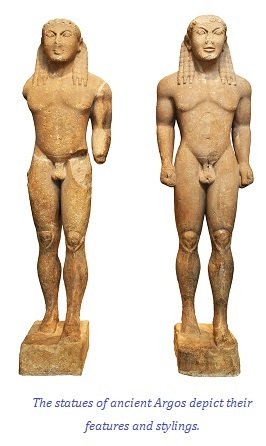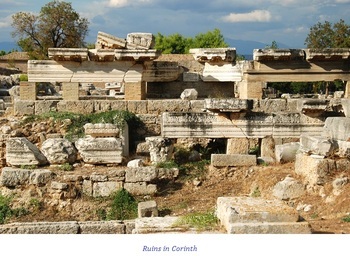

Ancient Argos, situated in the Peloponnese of Greece, was an important Mycenaean town during the Late Bronze Age (1700-1100 BCE) and remained so until its destruction by the Visigoths in 395 C.E. The site's most well-preserved examples of ancient architecture are the theater, formerly the biggest in Greece, and the ruins of Roman baths from the second century B.C.E. It flourished as a Mycenaean center. Still, it was smaller than Mycenae and Tiryns at the time.
During the dynamic leadership of King Pheidon in the seventh century B.C., Argos witnessed its greatest growth and strength.  Under Pheidon, Argos started to control the Argolid cities and became a powerful opponent of Sparta's supremacy in the “Peloponnese”. Argive warriors beat the Spartans in the Battle of Hysiae in 669–668 B.C., which is believed to have ended Spartan rule.
Under Pheidon, Argos started to control the Argolid cities and became a powerful opponent of Sparta's supremacy in the “Peloponnese”. Argive warriors beat the Spartans in the Battle of Hysiae in 669–668 B.C., which is believed to have ended Spartan rule.
In its heyday, Argos had pottery and bronze workshops, sculpting schools, tanneries, and clothing manufacturers. Additionally, the city hosted at least 25 events in addition to the usual exposition of local goods. A sanctuary built to be dedicated to Hera was discovered where the monastery of “Panagia Katekrymeni” now stands.
Persian wars were dubious since the city declined an offer to join the Hellenic League of Greek nations in 481 B.C.E and afterward either stayed neutral or demonstrated pro-Persian sympathies.
Around this time, Argos started to absorb neighboring kingdoms like Tiryns, Mycenae, and Nemea, perhaps due to the unrest in Greece. Finally, in 451 B.C.E., Argos and Sparta negotiated a peace deal for the next 30 years.
Argos' greater prominence among Greek city-states made it an excellent choice to take over as host of the biannual Panhellenic games, which had previously been hosted in Nemea, first from around 415 B.C.E to approximately 330 B.C.E.
Telesilla of Argos, the female poet, was one of the finest lyric poets of ancient Greece. A notable character from the city in the fifth century B.C.E. Pausanias, a Greek historian of the 2nd century C.E., credited Telesilla with arming a group of women and leading them against a Spartan army that attacked the city in 494 B.C.E. However, there is no proof of this in more contemporary sources.
Over most of the classical era, except for a short time between 418 and 416, Argos was a democracy. After the Spartans' catastrophic loss at the Battle of Sepeia in 494, democracy was first founded. The war resulted in the deaths of so many Argives.
The Argive democracy consisted of an Assembly (known as the alias), a Council (known as the bola), and a group known as "The Eighty," whose specific functions are unknown. With rare exceptions, magistrates served six-month terms and were audited after their mandates. One can find evidence of social exclusion.
During Roman administration, Argos was a part of the Achaea province. Although affluent during the early principate, Argos suffered during the Third Century crisis, when foreign threats and various revolts of the citizens created chaos in the Empire.
 Around 267 A.D., under the reign of Gallienus, bands of Goths and Heruli sailed from the Black Sea and ravaged the Greek shoreline and interior. As a result, Athens, Sparta, Corinth, Thebes, and Argos all faced their destruction. In Naissus in Moesia, Gallienus ultimately cut off their escape to the north and annihilated them with a massive massacre.
Around 267 A.D., under the reign of Gallienus, bands of Goths and Heruli sailed from the Black Sea and ravaged the Greek shoreline and interior. As a result, Athens, Sparta, Corinth, Thebes, and Argos all faced their destruction. In Naissus in Moesia, Gallienus ultimately cut off their escape to the north and annihilated them with a massive massacre.
In 396-397 A.D., after the last emperor’s death, Theodosius I, the Visigoths led by Alaric I marched to Greece, looting as they went. Due to the political position between them, the eastern and western Roman commanders, Rufinus (consul) and Stilicho, effectively stood against them.
Both Athens and Corinth were destroyed. Because of the internal conflict and disagreement of various sources, the precise degree of the devastation inflicted on Argos is debatable, although the city and its inhabitants suffered significant damage.
Argos later became an integral part of Byzantine, and Ottoman rule. Here are some of the characteristics of the time −
During the Byzantine administration, Argos was part of the “Hellas theme” and, subsequently, the Peloponnese theme.
At the time of the Fourth Crusade, the Crusaders took the fortress erected on Larisa Hill, where the old acropolis was, and the region came under the lordships of Argos and Nauplia.
The city was sold to the Republic of Venice in 1388, but the Despot of the Morea, Theodore I Palaiologos, captured it before the Venetians; he sold it to them in 1394. The Crusaders created a diocese in Latin. The Ottomans conquered the city in 1463, ending Venetian authority.
In 1397, the Ottomans pillaged and enslaved a large portion of the inhabitants of Argos.
The Venetians came and started living in the town again and the surrounding area with Albanian immigrants, granting them long-term exemptions from agricultural taxes.
Ancient Argos had seen so many kings and dynasties for a long period of time. Consequently, with time Argos people developed and welcomed various characteristics. Two of them are as follows −
The people of Argos were rich in education. As a result, they contributed a lot in the field of Astronomy, Mathematics, Philosophy, Medicine, etc.
The people of Argos were famous for their architecture. But one thing that was extremely noticeable was their sophisticated sculpture.
It is vital to comprehend why Argos is so popular. Argos was renowned for its horses. But it is also a city famous for various battles and newly-found democracy. Even though the Ottoman Empire is related to this, Argos had various attractive characteristics to seek people's attention.
Q1. Why did ancient Argos matter?
Ans. Argos has long been an integral part of Greek civilization. It is shown by the theatre's capacity of 20,000 seats, more significant than the renowned Theatre of Epidaurus.
Q2. Did Argos see any improvement during the Ottoman Empire?
Ans. After the Ottoman Empire took Argos in 1463, it enslaved most people of Argos.
Q3. What form of governance exists in Argos?
Ans. Their administration was a monarchy; a king reigned over Argos. According to Greek Mythology, Argos, the son of Zeus, built the city of Argos.